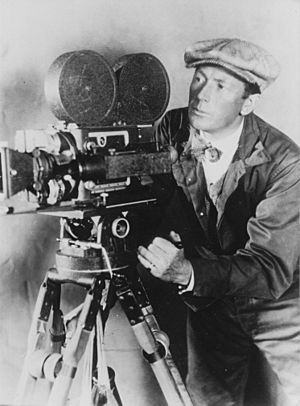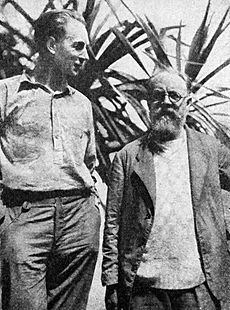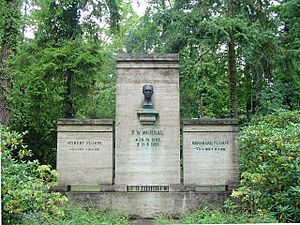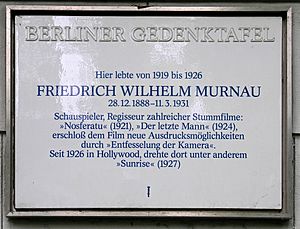F. W. Murnau facts for kids
Quick facts for kids
F. W. Murnau
|
|
|---|---|
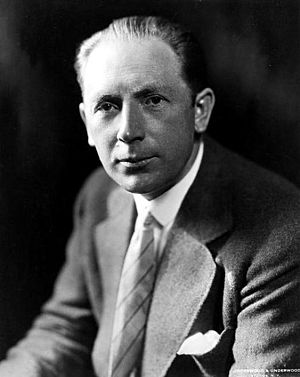
Murnau c. 1920–1930
|
|
| Born |
Friedrich Wilhelm Plumpe
December 28, 1888 Bielefeld, Germany
|
| Died | March 11, 1931 (aged 42) |
| Burial place | Südwestkirchhof Stahnsdorf, Germany |
| Alma mater | University of Berlin University of Heidelberg |
| Occupation |
|
| Years active | 1919–1931 |
| Movement | German Expressionism |
| Military career | |
| Allegiance | German Empire |
| Service/ |
|
| Battles/wars | World War I |
| Signature | |
Friedrich Wilhelm Murnau (born Friedrich Wilhelm Plumpe; December 28, 1888 – March 11, 1931) was a famous German film director, producer, and screenwriter. He is known for making some of the most important movies in film history.
Murnau was inspired by plays he saw as a child. He became friends with director Max Reinhardt. During World War I, he served in the German Army. He was an infantry commander and later an observer in the Flying Corps. He survived several plane crashes without serious injuries.
One of Murnau's most famous films is Nosferatu (1922). It was a scary vampire movie based on Bram Stoker's Dracula. Even though it had legal problems because of copyright, many people today think it's a classic. He also directed The Last Laugh (1924) and a film version of Faust (1926).
In 1926, Murnau moved to Hollywood. There, he made three films for Fox Studio. His movie Sunrise (1927) is often called one of the best films ever made by critics and other directors.
Murnau later traveled to Bora Bora to make the film Tabu (1931). He finished the movie by himself after some disagreements with his co-director. Sadly, a week before Tabu was released, Murnau died in a car accident near Santa Barbara, California. Out of the 21 films he directed, only 12 still exist completely today.
Contents
Early Life and Education
Friedrich Wilhelm Plumpe was born in Bielefeld, Germany. When he was seven, his family moved to Kassel. He had two brothers and two stepsisters. His father owned a cloth factory. Their home was often used as a stage for small plays that young Friedrich directed. He loved reading books by famous writers like Shakespeare and Ibsen from a young age.
Friedrich later chose the name "Murnau" as his professional name. He took it from a town called Murnau am Staffelsee near Munich, where he lived for a while. He was said to be very tall, about 6 feet 4 inches (193 cm).
Murnau studied languages at the University of Berlin. He also studied art history and literature in Heidelberg. There, a famous director named Max Reinhardt saw him in a student play. Reinhardt invited him to his acting school. During World War I, Murnau served as a company commander on the Eastern Front. He then joined the German Flying Corps. He flew missions in northern France and survived eight crashes. After landing in Switzerland, he was held as a POW until the war ended. While a prisoner, he joined a theater group and wrote a film script.
Film Career
After World War I, Murnau returned to Germany. He started his own film studio with actor Conrad Veidt. His first full-length film was The Boy in Blue (1919). It was a drama inspired by a painting. He also explored themes of different personalities in Der Janus-Kopf (1920).
Silent Film Masterpieces
Murnau's most famous film is Nosferatu (1922). It was a scary movie about a vampire, based on Bram Stoker's book Dracula. The film company went bankrupt because of a copyright lawsuit from Stoker's family. The court even ordered all copies of the film to be destroyed. However, one copy had already been sent out. This copy was duplicated many times, making Nosferatu an early example of a cult film (a film that gains a devoted following).
Murnau also directed The Last Laugh (1924). This film was special because it used a "subjective point of view" camera. This means the camera showed things from a character's eyes. It also used an "unchained camera technique," which involved moving the camera freely. This was new and exciting for filmmaking.
Murnau's last German film was Faust (1926). This was a big-budget movie based on the old legend and Goethe's classic story. The film is famous for a scene where the devil, Mephisto, flies over a town, spreading a plague. Both Nosferatu and Faust were among the first films to have original music scores.
Moving to Hollywood
In 1926, Murnau moved to Hollywood and joined Fox Studio. There, he made Sunrise: A Song of Two Humans (1927). Many experts consider this one of the greatest films ever made. Sunrise won several awards at the very first Academy Awards ceremony in 1929. It shared the award for "Unique and Artistic Production," which is similar to today's Best Picture award.
Murnau's next two films, 4 Devils (1928) and City Girl (1930), were changed to fit the new era of "talkie" films (movies with sound). They were not as popular. This made Murnau feel disappointed, so he left Fox. He decided to travel to the South Pacific.
While in Bora Bora, Murnau worked with documentary filmmaker Robert J. Flaherty to make Tabu (1931). Flaherty left the project due to creative differences, and Murnau finished the film himself. The movie was originally made as a silent film, which Murnau preferred.
Death and Legacy
On March 10, 1931, just a week before his film Tabu was set to open, Murnau was in a car accident. His car swerved to avoid a truck and overturned. Murnau suffered a head injury and died the next day in a hospital in Santa Barbara, California.
His body was sent back to Germany, where he was buried in the Southwest Cemetery in Stahnsdorf, near Berlin. Famous people like Robert J. Flaherty, Emil Jannings, and Fritz Lang attended his funeral. Actress Greta Garbo even had a special mask made of his face, which she kept on her desk.
In 2015, Murnau's grave was disturbed, and his skull was taken. This was not the first time something like this had happened at the cemetery. The skull has not been found since.
Murnau's life and films have inspired many artists. The author Jim Shepard wrote a novel called Nosferatu (1998) based on Murnau. In 2000, a film called Shadow of the Vampire was made about the making of Nosferatu. In this movie, Murnau is played by John Malkovich. The film imagines that Murnau hired a real vampire to play the main role! Murnau has also been mentioned in TV shows and other movies, showing how much his work continues to influence popular culture.
Filmography
| Original title | English title | Year | Notes |
|---|---|---|---|
| Der Knabe in Blau | The Boy in Blue / Emerald of Death | 1919 | Lost film, only small parts remain |
| Satanas | 1920 | Lost film, only small parts remain | |
| Der Bucklige und die Tänzerin | The Hunchback and the Dancer | 1920 | Lost film |
| Der Janus-Kopf | Dr. Jekyll and Mr. Hyde / The Head of Janus | 1920 | Lost film |
| Abend – Nacht – Morgen | Evening – Night – Morning | 1920 | Lost film |
| Sehnsucht | Desire: The Tragedy of a Dancer | 1921 | Lost film |
| Der Gang in die Nacht | Journey into the Night | 1921 | |
| Schloß Vogelöd | The Haunted Castle / Castle Vogeloed | 1921 | |
| Marizza, genannt die Schmuggler-Madonna | Marizza, called the Smuggler Madonna | 1922 | Mostly lost, one reel survives |
| Der brennende Acker | The Burning Soil | 1922 | |
| Nosferatu, eine Symphonie des Grauens | Nosferatu, a Symphony of Horror | 1922 | |
| Phantom | 1922 | ||
| Die Austreibung | The Expulsion | 1923 | Lost film |
| Comedy of the Heart | 1924 | Writer only | |
| Die Finanzen des Großherzogs | The Finances of the Grand Duke | 1924 | |
| Der letzte Mann | The Last Laugh | 1924 | |
| Herr Tartüff | Tartuffe | 1926 | |
| Faust | 1926 | Last German film | |
| Sunrise: A Song of Two Humans | 1927 | Won an Academy Award for Unique and Artistic Picture | |
| 4 Devils | 1928 | Considered one of Murnau's best, but it is a lost film | |
| City Girl | 1930 | ||
| Tabu: A Story of the South Seas | 1931 | Released after his death |
See also
 In Spanish: Friedrich Wilhelm Murnau para niños
In Spanish: Friedrich Wilhelm Murnau para niños


